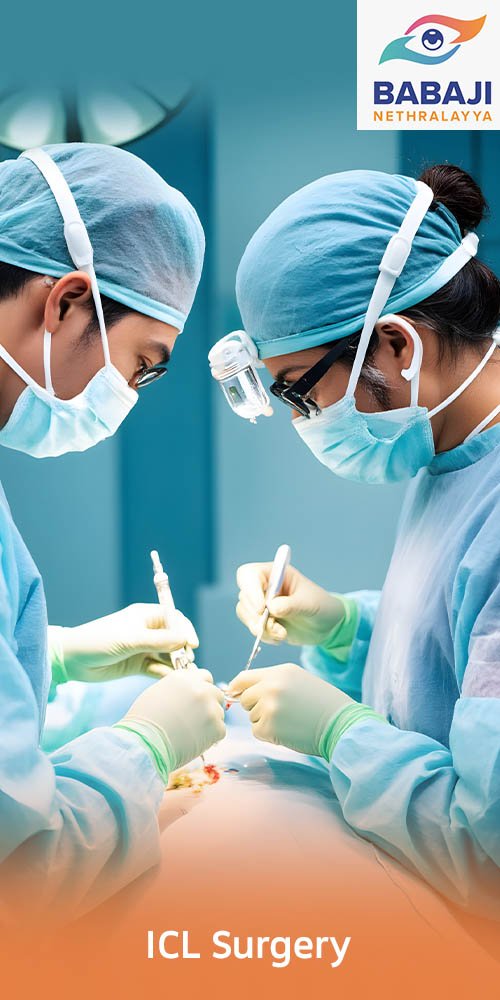
An ICL, also known as an Implantable Collamer Lens, is a unique and novel technology in which the biopolymer known as “Collamer” is used to make the implantable lens, which is perfectly compatible with the human eye and resistant to UV rays.
An ICL is an alternative to Lasik to correct near or far-sightedness and is a painless procedure. ICLs are a permanent solution to reduce dependence on contact lenses and glasses, and the best part? An ICL is bio-compatible and thus lasts a lifetime!
We at Baabaji Nethralaya are committed to delivering the best ICL procedure with subtlety and precision through our dedicated team of experts in eye care.
Is an ICL the right choice for me?
ICL procedures have been proven to be safe. However, there are a plethora of factors which can determine whether the patient can undergo the procedure, such as:
Age factor- the FDA approves ICL procedures for those between 20- 45 years of age.
Refractive errors- An ICL can be determined based on the type of refractive error in the eye and also the level of focussing error.
Compatibility with other procedures- In case the patient is not compatible with procedures such as Lasik, an ICL would be an option to consider.
Last but not the least, getting an ICL procedure would be dependent on the individual expectation from the surgery.
Is there any valid reason I wouldn’t be appropriate for Lasik eye surgery?
Lasik surgery has been a highly successful and popular procedure around the globe. But, there are certain conditions where Lasik might not be the right procedure for the patient, such as: having a high level of refractive aberration, presence of any comorbidities, and lifestyle. For those under a high risk of catching an infection, a Lasik is definitely not advised. In such conditions, an ICL is preferable as it does not debilitate the cornea and is a much safer option.
How ‘proven’ and safe is it?
ICLs have been proven safe by the USFDA and have also proven to be an emerging top choice as a corrective procedure with more than 2 million implantations. Research has found a substantial level of safety associated with ICLs, as there is a lower risk of infection, and they also do not cause dry eye syndrome, unlike other corneal procedures.
What is the Lens made of?
It is made of a biopolymer known as “Collamer,” derived from a naturally occurring protein known as Collagen. Biopolymers are absolutely safe to use and do not react with the body’s immune system.
Since an ICL is biocompatible, it does not react with the body and can stay forever unless there are changes in eyesight. They are also resistant to UV rays.
Who is appropriate for an ICL?
Patients who are especially appropriate for this lens are as per the following:
- Deficient corneal thickness for a Lasik eye surgery
- Forme Fruste or Clinical Keratoconus
- Past herpetic eye disease
- Astigmatism (Myopia) > -8D
- Far-Sightedness (Hypermetropia) >4D
- Far-Sightedness (Hypermetropia) >4D 6)Collagen vascular illness or different contraindications for Lasik.
Patients who are especially reasonable for this lens are as per the following:
Little eyes (lacking front chamber profundity (<2.8mm))
Sporadic astigmatism rendering poor BCVA
Glaucoma
Cataracts
Why choose ICL?
ICLs are gaining fast-paced demand for their versatile properties and minimal post-operative care. Some top reasons to consider an ICL are:
Biocompatibility of the lens with the human system reduces the risk of infection and hypersensitivity reactions.
The implants are easily removable and can be reversible.
Offers sharp and crisp vision since they are placed close to the nodal point.
Does not cause dry eye syndrome.
What is the best thing about an ICL?
An ICL preserves the corneal tissue and does not pose a risk of damage. They are also a boon for patients with thin corneas.An ICL also offers a wide correction range from -0.5D to -18D , which makes it the best!
What would I be able to expect after an ICL insert?
What is the recuperation time frame?
ICL Implants have a recuperation period similar to present-day LASIK eye surgery. After the surgery, there is a buffer time of about 4 hours until the patient can see clearly. All patients have accomplished an extremely acceptable level of vision within 24 hours of the surgery.
Why does it cost more than LASIK surgery?
Compared with LASIK eye surgery the ICL method uses a costly embed made to top-notch Swiss principles. The ICL is not held in stock and is requested, couriered, and in some cases ‘hand-made’ to fit a particular patient’s eye, in this way creation expenses are noteworthy.
Is the ICL visible to others?
No, it is placed behind the iris and is not visible to others.
Can you watch TV after the procedure?
It is advisable to not strain the eye upto 24 hours after the procedure.
Will I feel pain after the surgery?
Initially, there might be a minor sensation of a foreign particle in the eye, which will quickly settle upon blinking.
Will an ICL affect my night vision?
No, ICLs are known to enhance contrast sensitivity. This implies that anyone with the implant can see well in dimly lit places too.
What are the dangers?
- Risks
Although there is a chance of infection and other complications in any procedure, it was found that the level of risk in an ICL procedure is significantly low compared to other procedures.
2. Duration
The second eye can undergo the procedure within 2-days of the first procedure, yet some cases may take 1-2 weeks. It is advisable for those living outside the city to stay an extra day post-procedure for observation.
Will I feel anything during the surgery?
ICL is performed using anesthetic eye drops that eliminate sensation and pain during the procedure.
 73307 02025
73307 02025 baabajinethralaya@gmail.com
baabajinethralaya@gmail.com
